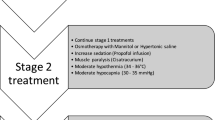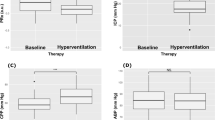Summary
Hyperventilation (HV) is routinely used in the management of increased intracranial pressure (ICP) in severe head injury. However, this treatment continues to be controversial because it has been reported that long-lasting reduced cerebral blood flow (CBF) due to profound sustained hypocapnia may contribute to the development or deterioration of ischemic lesions. Our goal in this study was to analyze the effects of sustained hyperventilation on cerebral hemodynamics (CBF, ICP) and metabolism (arterio jugular differences of lactates = AVDL). Co2-reactivity and CBF was estimated using AVDO2 (arteriojugular differences of oxygen content). Global cerebral ischemia and increased anaerobic metabolism were considered according to AVDO2 and AVDL respectively. Thirty-three patients with severe and moderate head injury and increased ICP were included. Within 72 hours after accident, patients were hyperventilated for a period of 4 hours. During this time jugular oxygen saturation (SjO2), arterial oxygen saturation (SaO2), ICP, mean arterial blood pressure (MABP), AVDO2 and AVDL were recorded.
In our study, most patients preserved CO2-reactivity (88.2%). In these cases HV was very effective in lowering ICP. Our findings showed that this reduction was due to a CBF decrease. According to basal AVDO2 twenty-five patients (75.7%) were considered as hyperemic and eight (24.2%) as not hyperemic. Global ischemia and increased anaerobic metabolism were detected in one case in the non-hyperemic group. According to AVDO2 and AVDL, no adverse effects were found during four hours of HV in hyperemic patients. Nevertheless, AVDO2 and AVDL are global measurements and might not detect regional ischemia surrounding focal lesions such as contusions and haematomas. We suggest that monitoring of AVDO2 or other haemometabolic variables should be mandatory when sustained HV is used in the management of head injury patients.
Access this chapter
Tax calculation will be finalised at checkout
Purchases are for personal use only
Preview
Unable to display preview. Download preview PDF.
Similar content being viewed by others
References
Adams H, Graham DI (1972) The pathology of blunt head injuries. In: Critchley M, O Leary JL, Jennett B (eds) Scientific Foundations of Neurology. London, William Heinemann, pp 478–491
Christesen MS, Paulson OB (1973) Cerebral apoplexy (stroke) treated with or without prolonged artificial hyperventilation: Cerebral circulation, clinical course and cause of death. Stroke 4: 568–619
Cold GE (1989) Does acute hyperventilation provoke cerebral oligaemia in comatose patients after acute head injury? Acta Neurochir (Wien) 96: 100–106
Cold GE, Jensen FT (1977) The cerebrovascular CO2-reactivity during the acute phase of brain injury. Acta Anaesth Scand 21: 222–231
DeSalles A, Muizelaar P (1986) Prognostic significance of ventricular CSF lactic acidosis in severe head injury. J Neurosurg 65: 615–624
Enevolsen EM, Cold G, Jensen FT (1976) Dynamic changes in regional CBF, intraventricular pressure, CSF pH and lactate levels during the acute phase of head injury. J Neurosurg 44: 191–214
Enevolsen EM, Jensen FT (1978) Autoregulation and CO2 responses of cerebral blood flow in patients with acute severe head injury. J Neurosurg 48: 689–703
Gibbs EL (1942) Arterial and cerebral venous blood. Arterial-venous differences in man. J Biol Chem 144: 325–332
Kety SS, Schmidt CF (1948) The effects of active and passive hyperventilation on cerebral blood flow and cerebral oxygen consumption of normal young men. J Clin Invest 27: 484–492
Muizelaar JP (1988) Pial arteriolar vessel diameter and CO2 reactivity during prolonged hyperventilation in the rabbit. J Neurosurg 69: 923–927
Obrist WD, Langfitt TW, Jaggi JL (1984) Cerebral blood flow and metabolism in comatose patients with acute head injury. J Neurosurg 61: 241–253
Plum F, Posner JB (1967) Blood and cerebrospinal fluid lactate during hyperventilation. Am J Physiol 212: 864–868
Sahuquillo J, Poca MA, Ausina A (1996) Arterio-jugular differences of oxygen for bedside assesment of CO2-reactivity and autoregulation in the acute phase of severe head injury. Acta Neurochir (Wien) 138: 435–444
Author information
Authors and Affiliations
Editor information
Editors and Affiliations
Rights and permissions
Copyright information
© 1998 Springer-Verlag Wien
About this paper
Cite this paper
Aguilar, A.A. et al. (1998). Cerebral Hemodynamic Changes during Sustained Hypocapnia in Severe Head Injury: Can Hyperventilation Cause Cerebral Ischemia?. In: Marmarou, A., et al. Intracranial Pressure and Neuromonitoring in Brain Injury. Acta Neurochirurgica Supplements, vol 71. Springer, Vienna. https://doi.org/10.1007/978-3-7091-6475-4_1
Download citation
DOI: https://doi.org/10.1007/978-3-7091-6475-4_1
Publisher Name: Springer, Vienna
Print ISBN: 978-3-7091-7331-2
Online ISBN: 978-3-7091-6475-4
eBook Packages: Springer Book Archive




